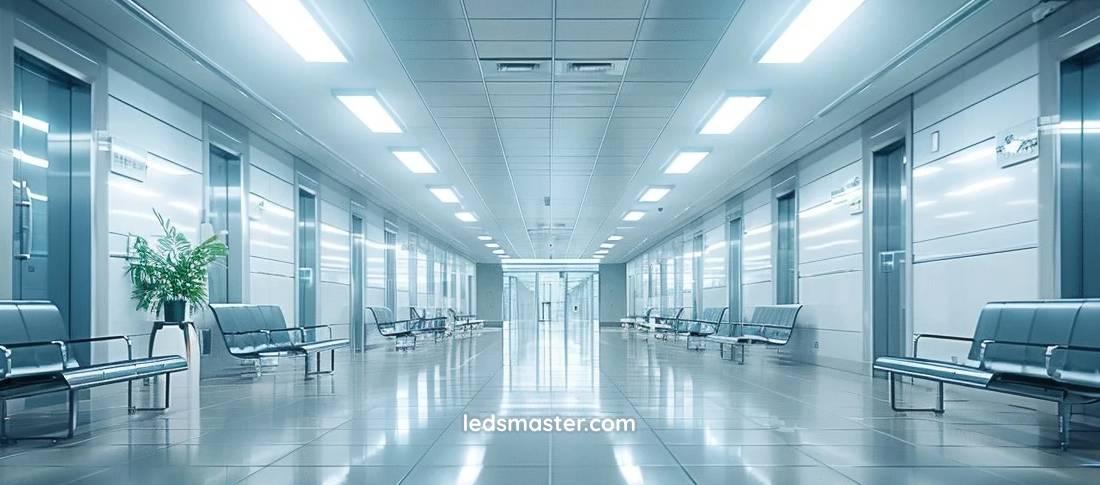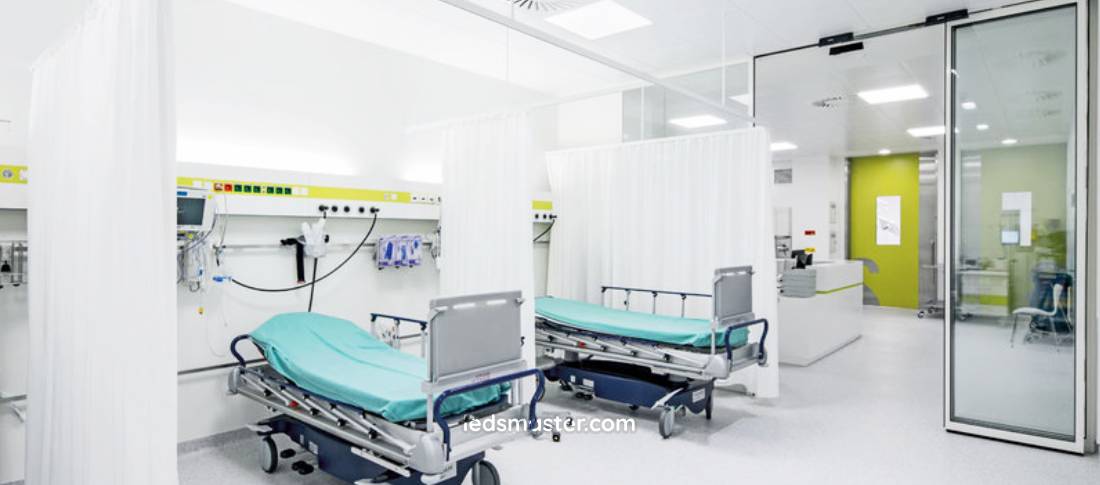Elevate patient rooms and healthcare spaces with our advanced lighting technology. Engineered for efficiency and comfort, our solutions promote well-being and productivity in every corner of your hospital.
Transform your hospital’s environment with our advanced lighting solutions, meticulously engineered for efficiency, comfort, and productivity. Designed to enhance every corner of your facility, our cutting-edge technology ensures optimal illumination while minimizing energy consumption. From creating a soothing atmosphere for healing to supporting precision in medical tasks, our solutions redefine lighting standards in modern healthcare facilities.
Get your complimentary lighting design today
Table of Contents
ToggleHospital lighting serves multiple functions. It provides the visibility required for medical procedures while also creating an environment that supports the well-being of patients and healthcare professionals alike. Unlike standard lighting configurations, hospital lighting systems are meticulously designed to adhere to rigorous standards for illumination, energy efficiency, and patient comfort. These considerations are not merely aesthetic; they directly impact health outcomes and the efficiency of healthcare delivery.

High-quality lighting ensures that healthcare professionals can perform procedures with the precision required for patient safety. For instance, surgical lighting must provide bright, shadow-free illumination to facilitate the accurate execution of intricate procedures. Any compromise in lighting quality could lead to errors, affecting patient safety and outcomes. Therefore, careful consideration must be given to the design and placement of lighting fixtures in critical areas of the hospital.
Hospital environments can evoke feelings of anxiety and discomfort among patients. Well-designed lighting plays a crucial role in alleviating these feelings, creating a sense of calm and safety. Lighting design should prioritize patient comfort, incorporating elements that foster relaxation and promote healing. The balance between adequate illumination and a soothing atmosphere is essential for enhancing the overall patient experience.
One of the factors influencing the effectiveness of hospital lighting is color temperature, which describes the warmth or coolness of light, measured in Kelvin (K). Different areas within a hospital can benefit from specific color temperatures tailored to their functions.
Cooler color temperatures, typically ranging from 5000K to 6500K, are employed in surgical suites and examination rooms. These cooler tones mimic natural daylight, promoting alertness and enhancing visual acuity among medical staff. In high-stakes environments such as operating rooms, where precision is crucial, the correct color temperature can significantly affect performance. Bright, cool lighting not only facilitates accurate procedures but also helps to maintain the alertness of healthcare workers during long shifts.
In contrast, warmer color temperatures, typically between 3000K and 4000K, are more suitable for patient rooms and recovery areas. These warmer hues create a calming atmosphere, conducive to relaxation and healing. The human psyche responds positively to warmer light, associating it with comfort and safety. By utilizing warmer color temperatures in areas where patients spend significant time, hospitals can foster a more inviting environment that aids in recovery.
A growing body of research supports the integration of daylight in hospital design to align with the natural circadian rhythms of patients and staff. Exposure to natural light has been linked to numerous benefits, including improved mood, better sleep quality, and enhanced overall well-being. Hospitals can incorporate daylight-mimicking features into their lighting systems, effectively simulating the dynamic changes in natural light throughout the day.
Natural light can serve as a powerful tool in promoting faster recovery rates among patients. Studies have shown that patients exposed to natural light in their recovery areas report lower levels of pain and stress. Additionally, exposure to daylight can help regulate the sleep-wake cycles of both patients and staff, leading to improved rest and recovery. This aspect of lighting design is increasingly being recognized as vital in creating healing environments.
Energy efficiency is a consideration in modern hospital lighting systems. Healthcare facilities consume a substantial amount of energy, and optimizing lighting solutions to minimize power usage without sacrificing illumination quality is essential. The shift toward energy-efficient lighting technologies is not only economically beneficial but also aligns with the broader movement towards sustainability in healthcare.
LED (Light Emitting Diode) technology has revolutionized hospital lighting. LEDs offer long-lasting, energy-efficient alternatives to traditional fluorescent and incandescent lighting. They consume significantly less energy and produce minimal heat, making them ideal for environments requiring continuous operation, such as hospitals.
In addition to energy savings, LEDs have a longer lifespan, reducing the frequency of replacements and the associated labor costs. The initial investment in LED lighting systems is often offset by these long-term savings, making them an attractive option for healthcare facilities aiming to optimize their operational budgets.
Advancements in lighting control technology have enhanced the flexibility and functionality of hospital lighting. Adaptive lighting control systems utilize sensors and automation to adjust lighting levels based on various factors, including occupancy, time of day, and natural light availability. These systems can dynamically respond to the needs of different spaces within a hospital, ensuring that lighting is always optimized for both energy efficiency and functionality.
Adaptive lighting control systems not only improve energy efficiency but also enhance the patient experience. By adjusting lighting levels based on real-time occupancy data, hospitals can create environments that are both responsive and welcoming. For example, corridor lights may dim during off-peak hours, conserving energy while still providing safety for patients and staff navigating the space.
Moreover, such systems can maintain consistent illumination levels across various areas of the hospital, ensuring that patients and healthcare providers benefit from well-lit environments tailored to their specific needs.
Thoughtfully designed lighting can significantly contribute to a sense of comfort and security, helping to alleviate anxiety levels among patients and their families. The emotional well-being of patients is intrinsically linked to their recovery processes, making the role of lighting in healthcare environments increasingly relevant.
Soft, diffused lighting in patient rooms can create a serene atmosphere for recovery and rest. Studies have shown that patients who feel comfortable in their environment are more likely to engage positively with their treatment and staff. A well-lit space can provide the reassurance patients need during a potentially stressful hospital stay.
Adjustable lighting settings allow patients to tailor their immediate surroundings to their preferences, fostering a sense of control and autonomy. When patients have the ability to modify their lighting, whether to dim the lights for rest or brighten them for social interaction, it enhances their overall experience. Empowering patients in this way can positively impact their emotional and psychological well-being during their stay.
Optimized hospital lighting is not solely beneficial for patients; it supports healthcare professionals as they perform their duties. The quality of lighting in medical facilities can significantly influence the effectiveness and efficiency of healthcare delivery.
Bright, focused lighting in surgical theaters and procedure rooms enhances visibility and precision during intricate medical tasks. The ability to see clearly and without glare is vital for surgeons and other medical staff, as even minor visibility issues can lead to errors. Hospitals that prioritize high-quality lighting can help reduce the risk of complications during procedures.
Moreover, glare-free illumination can mitigate eye strain and fatigue among medical staff. Long shifts in inadequately lit environments can lead to decreased concentration and increased errors in diagnosis and treatment. Properly designed lighting systems, tailored to the specific tasks performed in various areas, help promote sustained focus and accuracy among healthcare professionals.
By ensuring that medical staff have the optimal lighting conditions, hospitals can foster an environment where professionals can operate at their best, ultimately leading to better patient outcomes.
Human-centric lighting design emphasizes the importance of considering human factors, such as visual comfort and well-being, in lighting installations. Integrating these principles into hospital lighting design can result in environments that prioritize the needs of both patients and staff.
Human-centric lighting design considers several aspects, including light intensity, color temperature, and spectral distribution. By carefully balancing these factors, healthcare facilities can create environments that not only meet clinical needs but also enhance the psychological and emotional experiences of all users.
For example, ensuring that waiting areas are well-lit with softer, warmer tones can help reduce anxiety among patients awaiting treatment. In contrast, brighter, cooler lighting can be utilized in active treatment areas to keep healthcare professionals alert and focused.

Despite the numerous benefits of advanced hospital lighting systems, challenges persist. Initial implementation costs and ongoing maintenance requirements can be barriers to adopting new technologies.
Retrofitting existing facilities with modern lighting technologies often requires significant upfront investment. However, hospitals must weigh these initial costs against the long-term energy savings and improved patient outcomes associated with upgraded systems. While the transition to more efficient lighting may seem daunting, the potential return on investment through reduced energy costs and enhanced operational efficiency makes it a worthwhile consideration.
Additionally, ongoing maintenance and periodic upgrades ensure optimal performance and compliance with evolving healthcare standards and regulations. Hospitals must implement comprehensive maintenance plans that include regular inspections and updates to lighting systems. This proactive approach helps prevent issues that could compromise the quality of lighting and, consequently, the effectiveness of care.
Hospital lighting shape the healthcare experience. It affects patient recovery, comfort, and the overall well-being of healthcare professionals. By leveraging advancements in lighting technology, healthcare facilities can create environments that emphasize safety, sustainability, and patient-centered care.
The integration of intelligent lighting solutions will undoubtedly contribute to improved outcomes and enhanced operational efficiencies. As hospitals evolve to meet the changing needs of patients and staff, lighting design will remain a critical component in promoting health and well-being.
Ultimately, the consideration of lighting in hospital environments extends beyond mere visibility; it encompasses a holistic approach to design that prioritizes the physical and emotional needs of all users. By recognizing the profound impact of lighting on the healthcare experience, hospitals can cultivate spaces that nurture healing, support staff performance, and foster a positive atmosphere for everyone involved.
Hospital lighting serves as a vital component that influences not only the functional aspects of medical procedures but also the emotional and psychological experiences of patients and healthcare professionals alike. Through thoughtful design that incorporates considerations such as color temperature, daylight integration, and adaptive lighting systems, hospitals can create environments that promote healing, enhance comfort, and support operational efficiency.
The shift toward energy-efficient technologies like LED lighting reflects a commitment to sustainability while simultaneously providing high-quality illumination necessary for patient care. As we look to the future, innovations in smart lighting systems and data-driven analytics promise to further enhance the adaptability and responsiveness of hospital lighting. These advancements will allow healthcare facilities to fine-tune lighting conditions to meet the diverse needs of patients and staff, ultimately leading to improved outcomes and a more nurturing atmosphere.